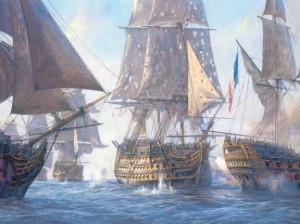“To any other Nation, the lost of a Nelson would have been irreparable, but in the British Fleet off Cadiz, every Captain was a Nelson.”—Vice Admiral Pierre Villeneuve, commander of the combined French-Spanish fleet, after the Battle of Trafalgar.
Master and Commander and a Book on Trafalgar Make Fascinating Companions
Indeed. “Fire on the up roll!” is a line from at least two salty sea sagas that come to mind. One’s a pirate movie—privateer, technically, The Sea Hawk (1940)—so I won’t go there this time, maybe in the future. The much newer film, which might’ve stolen the line from the first, as it’s such exciting, presumed nautical lingo, is of a non-pirate nature. After the seventeenth and early eighteenth centuries when pirates flourished, the next most popular period for ye olde sailin’ ship flicks is the late eighteenth, early nineteenth centuries, and specifically a great epoch of the time, the Napoleonic Wars, whose outcome meant the “turning of the earth,” as crucial in its time in shaping the world as World War I would be a little more than a century later.
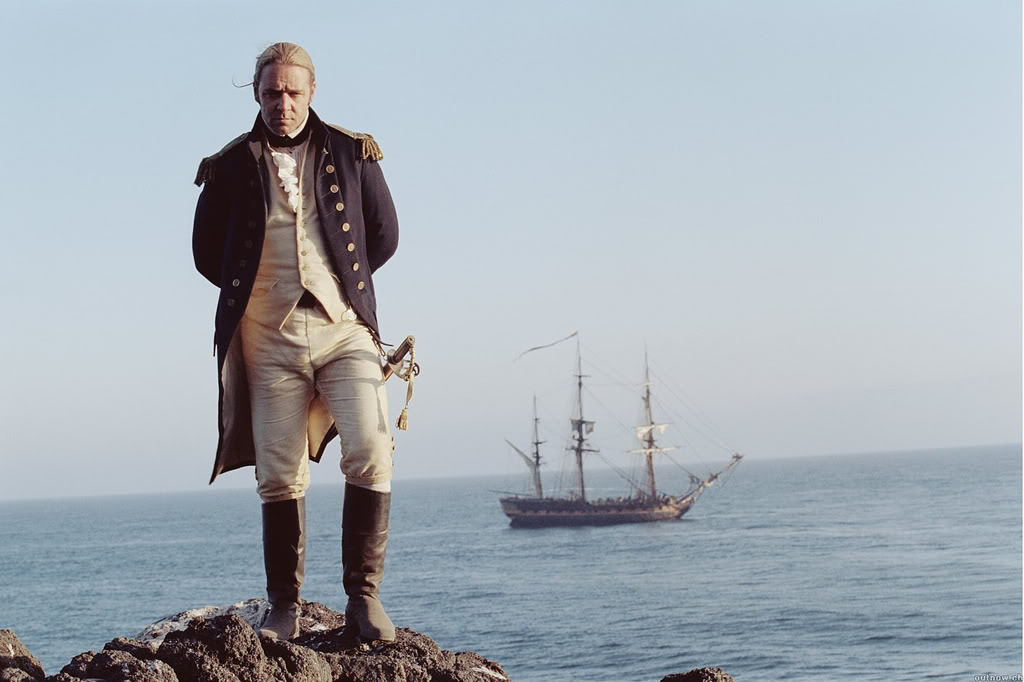 The movie I’m talking about—a third or fourth viewing ignited these thoughts—is Master and Commander: The Far Side of the World—full title now to be absolutely correct, hereafter halved for expedience. Although released as recently as 2003, and thereby technically ineligible for Hollywood’s Golden Age, it does meet many of the hallowed criteria of the glorious ’30s and ’40s.
The movie I’m talking about—a third or fourth viewing ignited these thoughts—is Master and Commander: The Far Side of the World—full title now to be absolutely correct, hereafter halved for expedience. Although released as recently as 2003, and thereby technically ineligible for Hollywood’s Golden Age, it does meet many of the hallowed criteria of the glorious ’30s and ’40s.
The film is based on the adventures of Patrick O’Brian’s fictional hero, Captain Jack Aubrey, during England’s latest and last fight with France. Actually there are some twenty books in the Aubrey series, and the film is based on selected incidences from at least five of them, two of the book titles comprising the film’s title, Master and Commander, written in 1970, and The Far Side of the World in 1984.
The author, who died in 2000, comes from a revered tradition of nautical writers, most often British. I’ve been in love with the sea since I can remember, and Rafael Sabatini’s Captain Blood (1922), purchased after I first saw the film as a young teenager, was the first sea tale I read. And, of course, there is Sabatini’s The Sea Hawk, set about a century earlier than Captain Blood, both long before the prerequisite Napoleonic period.
Rafael Sabatini’s Captain Blood and a Battle at Sea
 Perhaps a bit flowery for so-called “modern taste,” Sabatini’s (at right) writing nevertheless captures the spirit and authentic nautical flavor of what is absolutely essential in all sailing ship stories—a battle at sea. Take, for example, this excerpt from Chapter XXX of Captain Blood, “The Last Fight of the Arabella”:
Perhaps a bit flowery for so-called “modern taste,” Sabatini’s (at right) writing nevertheless captures the spirit and authentic nautical flavor of what is absolutely essential in all sailing ship stories—a battle at sea. Take, for example, this excerpt from Chapter XXX of Captain Blood, “The Last Fight of the Arabella”:
The sight of that great red ship with her gilt beakhead and open ports swinging broadside on must have given check to Rivarol’s soaring exultation. Yet before he could move to give an order, before he could well resolve what order to give, a volcano of fire and metal burst upon him from the buccaneers, and his decks were swept by the murderous scythe of the broadside. The Arabella held to her course, giving place to the Elizabeth, which, following closely, executed the same manœuvre. And then whilst still the Frenchmen were confused, panic-stricken by an attack that took them so utterly by surprise, the Arabella had gone about, and was returning in her tracks, presenting now her larboard guns, and loosing her second broadside in the wake of the first. Came yet another broadside from the Elizabeth and then the Arabella’s trumpeter sent a call across the water, which Hagthorpe perfectly understood.
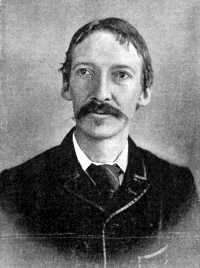 All convincing writers of ship and sail have inbred in them a love of the sea, like salt in the veins of sailors, and no man ever loved the sea more than a second author, Robert Louis Stevenson. (left) This passion for the sea permeates writings that have earned him a special niche all to himself. Treasure Island (1881), written to entertain his young stepson and often relegated to the lower echelon of a mere “boy’s adventure story” by a few wayward critics, is, however, one of the enduring classics. Possessing some of the poetic rhythm of the first paragraph of Edgar Allan Poe’s The Fall of the House of Usher, Stevenson’s opening brims with excitement and anticipation. We know, right off, that the tale has already happened, that, to borrow a movie term, it will now be told to us in flashback, and few readers are aware, so flowing is the cadence, that it’s all one sentence—over eighty-five words!:
All convincing writers of ship and sail have inbred in them a love of the sea, like salt in the veins of sailors, and no man ever loved the sea more than a second author, Robert Louis Stevenson. (left) This passion for the sea permeates writings that have earned him a special niche all to himself. Treasure Island (1881), written to entertain his young stepson and often relegated to the lower echelon of a mere “boy’s adventure story” by a few wayward critics, is, however, one of the enduring classics. Possessing some of the poetic rhythm of the first paragraph of Edgar Allan Poe’s The Fall of the House of Usher, Stevenson’s opening brims with excitement and anticipation. We know, right off, that the tale has already happened, that, to borrow a movie term, it will now be told to us in flashback, and few readers are aware, so flowing is the cadence, that it’s all one sentence—over eighty-five words!:
Squire Trelawney, Dr. Livesey, and the rest of these gentleman having asked me to write down the whole particulars about Treasure Island, from the beginning to the end, keeping nothing back but the bearings of the island, and that only because there is still treasure not yet lifted, I take up my pen in the year of grace 17—, and go back to the time when my father kept the “Admiral Benbow” inn, and the brown old seaman, with the saber cut, first took up his lodging under our roof.
I remember him as if it were yesterday, as he came plodding to the inn door, his sea-chest following behind him in a handbarrow; a tall, strong, heavy, nut-brown man; his tarry pigtail falling over the shoulders of his soiled blue coat; his hands ragged and scarred, with black, broken nails; and the saber cut across one cheek, a dirty, livid white. I remember him looking round the cove and whistling to himself as he did so, and then breaking out in that old sea-song that he sang so often afterward:
“Fifteen men on the Dead Man’s Chest—
Yo-ho-ho, and a bottle of rum!”
The “old seaman with the saber cut” is not, of course, Long John Silver but Captain Billy Bones.
C. S. Forester’s Hornblower from Captain to Admiral
 C. S. Forester (right) is a third maritime writer. Although an Englishman (born in Cairo), he lived and wrote in America, creating there his naval hero, one Horatio Hornblower. Forester had died a few years before O’Brian published the first of his Jack Aubrey installments, Master and Commander. The numerous volumes of Hornblower’s adventures follow his career from midshipman to admiral. If the character’s first name isn’t clue enough, Forester admitted that his model was Lord Admiral Horatio Nelson. Here, early in Chapter VIII of Hornblower and the Atropos (1953), Hornblower is trying to navigate his ship in a fog:
C. S. Forester (right) is a third maritime writer. Although an Englishman (born in Cairo), he lived and wrote in America, creating there his naval hero, one Horatio Hornblower. Forester had died a few years before O’Brian published the first of his Jack Aubrey installments, Master and Commander. The numerous volumes of Hornblower’s adventures follow his career from midshipman to admiral. If the character’s first name isn’t clue enough, Forester admitted that his model was Lord Admiral Horatio Nelson. Here, early in Chapter VIII of Hornblower and the Atropos (1953), Hornblower is trying to navigate his ship in a fog:
While the bells were still sounding Hornblower took note of the position of the minute hand of his watch and nodded to Jones. Instantly came a roar of orders; the men, already called to attention after their brief stand-easy, came pouring aft with their petty officers urging them on. Watch in hand, Hornblower stood back by the taffrail. From where he stood only the lower part of the main rigging was visible; the foremast was completely hidden in fog. The hands went hurrying up the ratlines, Hornblower watching keenly to see what proportion of them were vague about their stations and duties. He could have wished that he could see all that was going on—but then if there had been no fog there would have been no sail drill, and Atropos would have been making the best of her way down-Channel.
 And, last among these “official” nautical writers, there is Patrick O’Brian himself (left), and to set the sails, as it were, for the discussion of this 2003 movie, here’s a quote from Chapter V of Master and Commander. No, not a battle this time, but, for contrast, a vivid description of the weather, with the expected nautical nomenclature:
And, last among these “official” nautical writers, there is Patrick O’Brian himself (left), and to set the sails, as it were, for the discussion of this 2003 movie, here’s a quote from Chapter V of Master and Commander. No, not a battle this time, but, for contrast, a vivid description of the weather, with the expected nautical nomenclature:
The sun set over the starboard bow, the wind began to back into the north, blowing in gusts, and darkness swept up the sky from behind them: the polacre [a three-mast sailing vessel used in the Mediterranean] was still three-quarters of a mile ahead, holding on to her westward course. As the wind came round on to the beam they set staysails and the fore-and-aft mainsail: looking up at the set of the fore-royal and having it braced round more sharply, Jack could see it perfectly well; but when he looked down it was twilight on deck.
Now, with the studding sails in, the chase—or the ghost of the chase, a pale blur showing now and then on the lifting swell—could be seen from the quarter-deck, and there he took up his stand with his night-glass, staring through the rapidly gathering darkness, giving a low, conversational order from time to time.
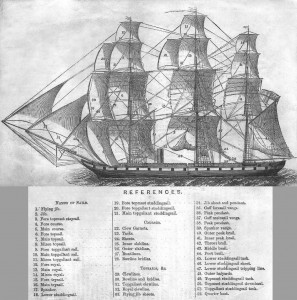 (For any possible landlubbers, right handy should be an illustration identifying the names of the sails of a square-rigged ship, as provided in each O’Brian volume. Such an illustration, which I found totally enthralling, the kind of brain stimulus I crave, a close friend of mine found it of the least possible interest conceivable!)
(For any possible landlubbers, right handy should be an illustration identifying the names of the sails of a square-rigged ship, as provided in each O’Brian volume. Such an illustration, which I found totally enthralling, the kind of brain stimulus I crave, a close friend of mine found it of the least possible interest conceivable!)
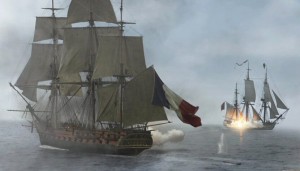 “Studding sails”? Remember when that master navigator Captain Aubrey was struggling to keep his H.M.S. Surprise out of cannon range of the Acheron, which had more guns? He was hoping to elude the enemy until nightfall, when he could rig his dummy ship with the empty water casks supporting a small mast, sail and three lanterns. Well, he had ordered studding sails to gain maximum speed: they are sails on a special spar, extended out over the water, abeam of the ship.
“Studding sails”? Remember when that master navigator Captain Aubrey was struggling to keep his H.M.S. Surprise out of cannon range of the Acheron, which had more guns? He was hoping to elude the enemy until nightfall, when he could rig his dummy ship with the empty water casks supporting a small mast, sail and three lanterns. Well, he had ordered studding sails to gain maximum speed: they are sails on a special spar, extended out over the water, abeam of the ship.
One more author? A minor one, to be sure. From part of Chapter IV of an as yet untitled novel there is this:
Peter Flanders saw a need for improvement in the crew’s response to beat to quarters. He had long before discovered through practical trial and error that the merit of crew and ship was tested when a ship encountered a ship of her own class: then a crew made the difference, then the battle was not ship against ship, nor even cannon against cannon, but men against men, as a fight should be. But, alas, this imminent engagement he now expected would not be a real test, he feared. How well his Englishmen defeated the foolhardy French, who now lay several leagues off the starboard bow—whether marginally or significantly—would settle nothing. Flanders had already decided, though he had yet to tell any one, that he’d persuade Admiral Lyden to make his Damon Royce the flagship of the fleet at Monmouth Island. Whatever was needed, he would turn this ship and its crew into an invincible fighting machine. The Damon Royce, he felt sure, had many of the qualities of the prototype of the Sovereign of the Seas, built in 1637 when a navy was needed against the Dutch. For almost two centuries the essential design of the first-rate ship-of-the-line had remained unchanged, and the truth in the phrase “wooden walls,” passed down through generations of English mariners, was proven in the testimony of their enemies.
Yes, by Yours Truly, from a novel written many years ago and never finished, this paragraph only in a first draft stage. So even then, I was thinking, writing, sometimes it seemed, living the Napoleonic Wars!
